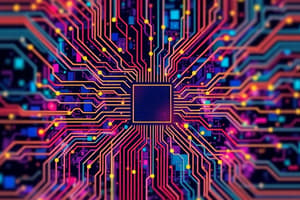Podcast
Questions and Answers
What is the term for a semiconductor material that has equal numbers of electrons and holes?
What is the term for a semiconductor material that has equal numbers of electrons and holes?
- P-type semiconductor
- Intrinsic semiconductor (correct)
- Extrinsic semiconductor
- N-type semiconductor
What is the effect of heavy doping on the conductivity of semiconductor material?
What is the effect of heavy doping on the conductivity of semiconductor material?
- Has no effect on conductivity
- Increases the resistance
- Increases the conductivity (correct)
- Decreases the conductivity
What type of semiconductor material has a shortage of electrons?
What type of semiconductor material has a shortage of electrons?
- Extrinsic semiconductor
- P-type semiconductor (correct)
- N-type semiconductor
- Intrinsic semiconductor
What is the term for the most abundant carrier in a semiconductor material?
What is the term for the most abundant carrier in a semiconductor material?
Which type of impurity atom increases the number of holes in a semiconductor material?
Which type of impurity atom increases the number of holes in a semiconductor material?
What is the term for a semiconductor material that has been doped with other atoms?
What is the term for a semiconductor material that has been doped with other atoms?
What is the main type of charge carrier in an N-type semiconductor?
What is the main type of charge carrier in an N-type semiconductor?
What is the term for an impurity atom that increases the number of electrons in a semiconductor material?
What is the term for an impurity atom that increases the number of electrons in a semiconductor material?
What is the main type of charge carrier in a P-type semiconductor?
What is the main type of charge carrier in a P-type semiconductor?
What is the least abundant carrier in a semiconductor material?
What is the least abundant carrier in a semiconductor material?
Flashcards are hidden until you start studying
Study Notes
Introduction to Electronics
- Electronics is the branch of physics and engineering concerned with the design of circuits using transistors and microchips, and with the behavior and movement of electrons in a semiconductor, conductor, vacuum, or gas.
- Electronics is also the science of how to control electric energy.
- Basic electronic components include resistors, capacitors, inductors, transformers, diodes, transistors, and integrated circuits.
Resistance
- The resistance of a material is the opposing force that a flowing charge encounters.
- All materials have a resistance that is dependent on cross-sectional area, material type, and temperature.
- A resistor dissipates power in the form of heat.
- A resistor in an electronic circuit can be in series, parallel, star, or delta.
Capacitor
- A capacitor is used to store charge for a short amount of time.
- A capacitor is a device that stores energy in an electric field, consisting of two conductive plates separated by a non-conductive material.
- Capacitors are rated by the amount of charge that can be held (in Farad) and the voltage handling capabilities.
Semiconductors
- Semiconductors are classified into two types: intrinsic and extrinsic.
- Intrinsic semiconductors contain no impurities and no crystalline defects.
- Extrinsic semiconductors are classified into two types: N-type and P-type.
N-type Semiconductors
- N-type semiconductors contain more electrons than holes.
- In an N-type semiconductor, conduction is mainly due to electrons (negative charges).
- Positive charges (holes) are the minority carriers.
P-type Semiconductors
- P-type semiconductors contain more holes than electrons.
- In a P-type semiconductor, conduction is mainly due to holes (positive charges).
- Negative charges (electrons) are the minority carriers.
Carrier Movement
- There are two mechanisms by which holes and free electrons move through a silicon crystal: drift and diffusion.
- Drift current is generated by the electrical field across a piece of silicon.
- Diffusion current is generated by the different concentration of carriers in a piece of silicon.
Silicon
- Silicon is a tetravalent element, which means it has four valence electrons and four vacancies.
- In intrinsic (pure) silicon, atoms join together by forming covalent bonds.
- Each atom shares its valence electrons with each of four adjacent neighbors, effectively filling its outer shell.
Electronic Properties of Si
- Silicon is a semiconductor material.
- Pure Si has a relatively high electrical resistivity at room temperature.
- There are two types of mobile charge-carriers in Si: electrons (negatively charged) and holes (positively charged).
Intrinsic Semiconductors
- A semiconductor is said to be intrinsic if it contains no impurities and no crystalline defects.
- The structure has zero overall charge.
- At absolute zero, every electron is at the lowest energy state, and the states in the conduction band are empty.
- Electrons leaving the VB to CB creates a vacancy called hole in the valence band.
Thermal Generation and Recombination
- At room or higher temperatures, electrons acquire thermal energy, which is transferred to them from the crystal lattice.
- Phonons can excite electrons from the valence band (VB) to the conduction band (CB).
- Electrons leaving the VB to CB creates a vacancy called hole in the valence band.
- The free electrons in the semiconductor can fall into holes in a process known as recombination.
- Energy is given up by the electrons in this process.
Studying That Suits You
Use AI to generate personalized quizzes and flashcards to suit your learning preferences.




